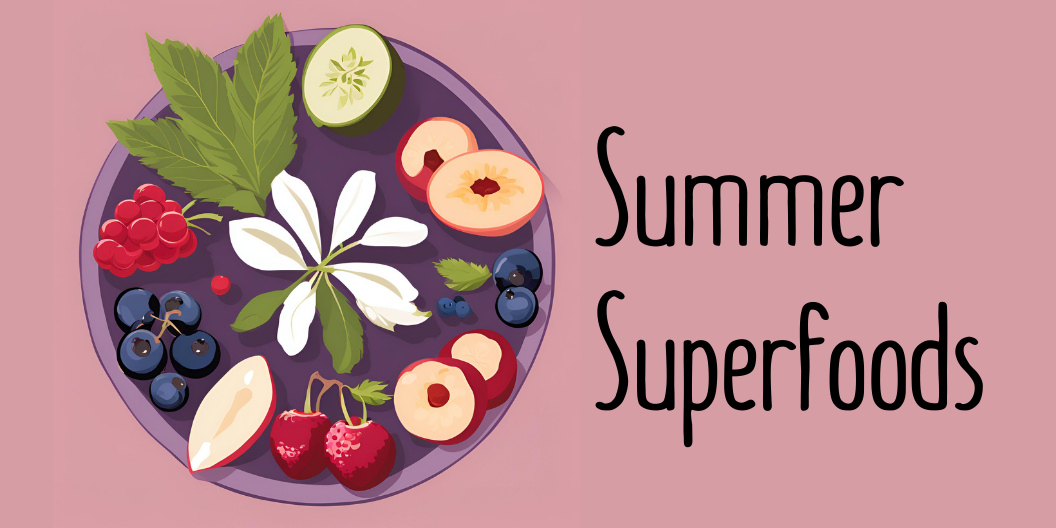Summer Superfoods

I was listening to an episode from Alvaro Vargas’ podcast titled “To eat we learn” (literal translation from Spanish), and I decided to write this first blog entry as I learn about the topic.
Just by scratching the surface I can tell that there are many approaches to describe what a Superfood is. For now I will stick with Alvaro’s description:
“A superfood is an aliment that has a high nutritional density - meaning they are particularly rich in vitamins and minerals. We don’t consider aliments high on carbohydrates, proteins or fat to be superfoods, since these elements are easily findable.”
Are you excited to find out what the superfoods are, and why they are named like that? Come with me onto the learning hall! The place where I learn some theory and tidy it up for you to learn with me!

The 4 superfoods Alvaro recommends for the summer are:
‘Red fruits’ - Rasbperries, blueberries and cherries.
‘Red fruits’ are especially high in Vitamin A and Vitamin C, both of which protect the cells in the human body from damage caused by oxidative stress. This stress can result from normal metabolic activities, inflammation, exposure to pollution, radiation, and cigarette smoke. The principal micronutrients we find in red fruits are:
- Vitamin A: Helps maintain healthy vision, supports the immune system, and ensures proper functioning of the heart, lungs, kidneys, and other organs.
- Vitamin C: Necessary for the growth, development, and repair of all body tissues. It is involved in many body functions, including the absorption of iron, the immune system, wound healing, and the maintenance of cartilage, bones, and teeth.
- Anthocyanins: These are powerful antioxidants found in high concentrations in red fruits. They help reduce inflammation, lower blood pressure, and improve visual and neurological health.
*Blueberries: Although blueberries are not red, they are categorised like red fruits because they share similar health benefits and high antioxidant content. Blueberries are blue due to their high anthocyanin content, which is the same pigment that gives other red and purple fruits their color. The anthocyanins in blueberries help reduce oxidative stress and inflammation, lower blood pressure, and improve brain health. Compared to other red fruits, blueberries have been specifically noted for their cognitive health benefits, earning them the nickname "brain berries."
Fun fact about 'red fruits': Cherries can help improve sleep quality! They are one of the few natural sources of melatonin, the hormone that regulates sleep-wake cycles. Eating cherries or drinking cherry juice can help you fall asleep faster and enjoy a more restful night's sleep.
Eggplants
Eggplants, also known as aubergines, are nutrient-dense vegetables that offer a variety of health benefits. They are a great source of vitamins, minerals, and antioxidants. Eggplants are rich in fiber, which helps in regulating blood sugar levels, making them beneficial for individuals with diabetes. Additionally, eggplants contain nasunin, a powerful antioxidant found in the skin, which protects the cells from damage and supports brain health. The micronutrients we find in eggplants include:
- Vitamin C
- Vitamin K: Essential for blood clotting and bone health, vitamin K helps the blood to clot and works with calcium to build bones and prevent bone fractures.
- Potassium: Aids in maintaining proper electrolyte balance, muscle contraction, and nerve function. Helps regulate blood pressure and reduce the risk of stroke.
- Nasunin: This antioxidant is particularly potent in the skin of eggplants. Nasunin has been shown to protect brain cell membranes from damage, support cognitive function, and reduce the risk of neurodegenerative diseases.
- Manganese: An essential trace element, manganese is involved in bone formation, blood clotting, and reducing inflammation. It also plays a role in metabolism and the regulation of blood sugar.
Fun fact about eggplants: Eggplants are botanically classified as berries! Despite their common association with vegetables, they belong to the nightshade family, which includes tomatoes and potatoes.
Leek
Leeks are related to garlic, onions, and shallots. They are known for their immune-boosting properties, helping strengthen the immune system by aiding the body in defending against pathogens. They have a diuretic effect due to their high potassium and low sodium content, which helps the body eliminate excess fluids. They are also high in fiber, promoting healthy digestion and aiding in the maintenance of a healthy gut. They contain mucilage, a gel-like substance similar to that produced by chia seeds, which can soothe the digestive tract. The micronutrients we find in leeks include:
- Manganese
- Vitamin K: Essential for blood clotting and bone health, vitamin K activates proteins that help the blood to clot and works with calcium to build bones and prevent bone fractures.
- Folate (Vitamin B9): Crucial for DNA synthesis and repair, folate aids in rapid cell division and growth. It's especially important during periods of rapid growth such as pregnancy and infancy.
Fun fact about leeks: In Wales, leeks are a national emblem. According to legend, soldiers wore leeks in their hats to distinguish themselves from their enemies during a battle against the Saxons.
Peach
Peaches are particularly rich in fiber, vitamins and antioxidants. But their main treat is their level of Malic Acid, that plays a role in cellular energy production. The micronutrients we find in peaches are:
- Vitamin A
- Vitamin C
- Potassium
- Fiber: Peaches are a good source of dietary fiber, which promotes digestive health by facilitating regular bowel movements and feeding beneficial gut bacteria.
Fun fact about peaches: Peaches are a member of the rose family, making them relatives of almonds and even roses themselves! In ancient China, peaches were considered a symbol of immortality and unity.
Each superfood described here offers unique properties that support various bodily functions. We are barely scratching the surface. What other superfoods or nutritional topics would you like to learn about? Tell me and i will do all the research for you 🤓
Want to be part of a business idea on this topic? Complete this short survey and let me know!
The witchy corner
I have a special place in my life for spirituality and intuitive knowledge. If you are interested in such things, please keep reading what i have in store at the witchy corner.

In this section, i will try to find links between the nutritional facts we just learnt with the concept of chakras - 7 energy points in the body that allow energy flow through our body, from the earth to the sky, and within.
Shout out to my friend Jessy who gifted me 'The Chakra Bible’ 😁. Thanks to this book I discovered the chakras, and that each of them have a colour. Apparently, foods of that colour will help balance the correspondent chakra!
For context, a bite-sized useful chart about chakras that i found on Google:

Now, let’s compare the colors of the foods with each of the chakras and verify if there’s a match between the body function of the nutrient with the energetic function of the chakras. For our experiment, let’s classify our superfood into colors and match with the correspondent chakra!
Root chakra (red)
Description of the chakra function
Channels Earth energy upwards through the feet. The body recognises this as a signal to balance the endocrine system thorugh the release of hormones.
Description of the Superfood nutritional benefits
Raspberries, cherries: Protect the cells in the human body from damage caused by oxidative stress. This stress can result from normal metabolic activities, inflammation, exposure to pollution, radiation, and cigarette smoke.
Sacral chakra (orange)
Description of the chakra function
When fully developed, produces necessary radiance to unite in a bond of love with another soul and fuels the growth of consciousness and enlightenment.
Summary of the Superfood nutritional benefits
Peaches: Powerful nutritional profile that supports the health and function of your body's cells. Good source of dietary fiber, which facilitates regular bowel movements and feeds beneficial gut bacteria.
Heart chakra (green)
Description of the chakra function
Midpoint in the seven chakras and in the body, is considered a gateway to higher through. Its fire is fuelled by the love of creation - the same love that causes us to delight in the feel of soft rain or the scent of a flower.
Summary of the Superfood nutritional benefits
Leeks: They help strengthen the immune system, aiding the body in defending against pathogens. Additionally, leeks have a diuretic effect due to their high potassium and low sodium content, which helps the body eliminate excess fluids.
Third-eye chakra (deep blue)
Description of the chakra function
When we fully associate with its power, we are able to step beyond the mind, with all its desires and longings, and enter the realms of knowledge and wisdom.
Summary: of the Superfood nutritional benefits
Blueberries: Enhance cognitive function and improve memory. They are one of the only foods that are naturally blue in color, thanks to their high anthocyanin content.
Crown chakra (purple)
Description of the chakra function
Symbolises the balance of duality within us and our ability to experience super-consciousness, and then the bliss of transcendental consciousness.
Summary of the Superfood nutritional benefits
Eggplants: Aids in digestion and promotes a healthy gut. Regulates blood sugar levels, protects the skin cells from damage and supports brain health.
Sounds fair enough to me! I find the link between the crown chakra and eggplants to be quite interesting. Since our body is our temple, it is meaningful that eggplant has such a holistic impact, aiding the health of our skin, our blood, our brain and even our gut. Makes me think that my next post could be about desciphering the phrase "follow your gut". Spoiler: The gut 100% relates to intuition.
Phew! This article was harder to write than I expected. It was quite a journey to run this investigation with my pal ChatGPT. This is such an immense topic I have content to write about this until the end of my days. So, if you are keen, help me focus my energies by telling me if there is there anything specific you are curious about. It’s much appreciated! 😃



